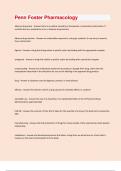Exam (elaborations)
Penn Foster Pharmacology (Questions + Answers) Verified 100% Correct!!.
- Course
- Institution
Adverse drug event - Answer-harm to a patient caused by a therapeutic or preventive intervention. It could be due to a medication error or adverse drug reaction Adverse drug reaction - Answer-an undesirable response to a drug by a patient. It may vary in severity from mild to fatal Agonist - An...
[Show more]



